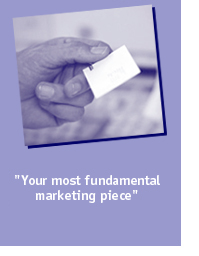
What Your Card Says About You
| Продажи | ||||
| Sales.com | ||||
| Making... | ||||
by Graham Denton
You may not think of giving someone your business card as a presentation, but that's exactly what it is. It's one of the first important elements of your self-presentation. Small as it is, your business card is a powerful vehicle for informing potential clients and associates how you want to be perceived in a professional capacity. If your card isn't professional, neither are you.
 It's
with this in mind that business writer Don Cooper calls the business card
"your most fundamental marketing piece." Making that piece effective,
he says, means attending both to content and to style. Here are some of
his tips for getting it right.
It's
with this in mind that business writer Don Cooper calls the business card
"your most fundamental marketing piece." Making that piece effective,
he says, means attending both to content and to style. Here are some of
his tips for getting it right.
Use your "real" name. This means the name that people know you by, and by which you introduce yourself. Your business card should "reinforce your verbal introduction rather than conflict with it." So if your given name is Alexander S. George III but you go by "Sandy," the "proper" form on the card is "Sandy George."
Make yourself visible. This can mean using a photograph of yourself, your company logo, or some other graphic. Just don't be afraid to brighten the card up - it's guaranteed to make the impression more memorable. This goes as well for the colors of the paper and the ink. Avoid the splashy and the technicolor, sure, but don't confine yourself to black and white. Cooper assesses that contrast as "dull, dull, dull."
Avoid the "arty" look. As elegant as you think pale gray on white may appear in theory, it's much more likely, in practice, to disappear. And your presentation will mean nothing if the client can't see it. The same thing goes for teensy-tiny type faces, and the jumbled, mixed-font types that are so popular in the e-zines. They might wow the profs at your daughter's design school, but they're unlikely to earn you any points in the business world.
Splurge on the paper. Use the "thickest, nicest paper you can afford" and have the cards made up by a professional typesetter. Yes, the laser-printed cards that you can get at the local photocopy shop are cheaper. They trouble is, they look it. Remember the old adage: You only get one chance to make a good first impression. Don't blow it to save five bucks on a thousand cards.
Use both sides. If you don't, Cooper says, "you're missing out on a great marketing opportunity." Put "something of value" on the back, like a calendar, some useful tips, or a testimonial. If you do business abroad, put your basic "who I am" data in the relevant language. Some of the classiest cards I've seen have English on one side, Japanese on the other.
Be thorough. The point of the card, after all, is to help people contact you. So include all your relevant contact information: address, phone, fax, email, website. If you're old enough to remember the television show Have Gun, Will Travel, you'll remember that the gunslinger Paladin's card read simply "Have Gun, Will Travel - Wire Paladin, San Francisco." Very sexy card, in TV Land. Lousy card if you actually want to drum up any business.
Cooper's implied final word is "You get what you pay for." If your email has just changed, for example, avoid the so-called thrifty option of stick-on updates: "Get new cards printed immediately." The same advice goes out to the corporate managers who believe that three names on a card are cheaper than one. That may be so, but do you want your company's clients to identify you as cheap? "Every person in your organization should have his or her own card."
Don Cooper is the author of The Little Black Book for Doing Business in Metropolitan Washington (1998), a contributing editor for Money magazine, and one of the featured writers on the Guerrilla Group website, from which these remarks are adapted.